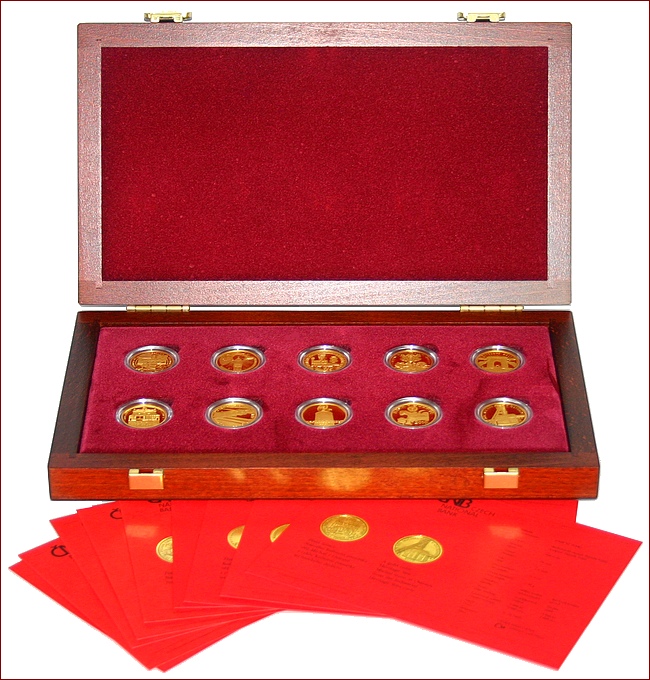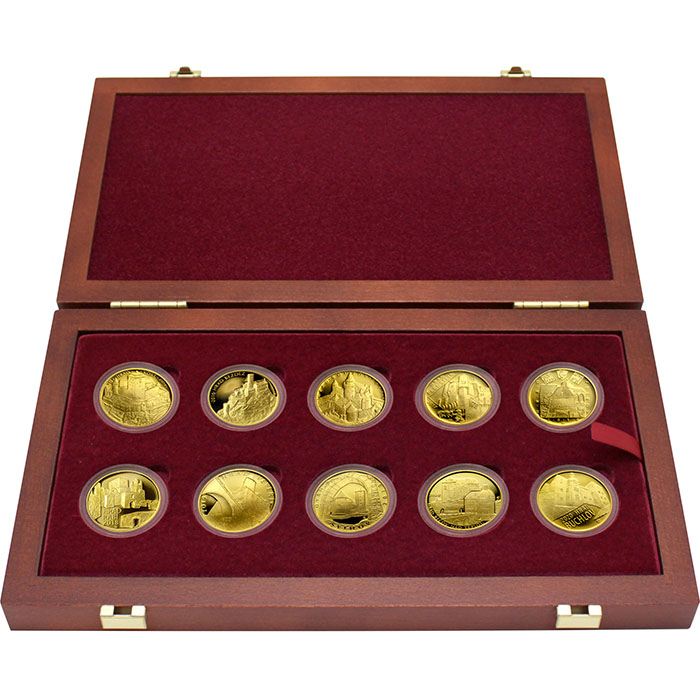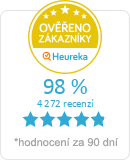Set of Cultural Monuments of Technical Heritage 10 Gold Coins 2006 - 2010 Proof
The product cannot be ordered now.
NOT IN STOCK
Detailed description
CULTURAL MONUMENTS OF TECHNICAL HERITAGE
Ten gold commemorative coins issued between 2006 and 2010
A set of 10 rare gold coins issued by the Czech National Bank between 2006 and 2010. The motifs on the coins accurately depict cultural monuments of technical heritage. This set of gold coins is rarely seen and is therefore highly sought after by collectors and investors. The coins are supplied without a box and with an individual postcard-size certificate of authenticity for each coin.
Paper mill Velké Losiny
The paper mill was built on the site of the former grain mill by Jan the Younger of Žerotín. According to the sources, the paper mill started production as one of the enterprises of the developing upper-class economy sometime between 1591 and 1596. For the first time, the existence of the paper mill is commemorated by its oldest known broadside from 1596 in the form of the Žerotín coat of arms - a lion with a crown standing on three hills. From its inception until the second half of the 18th century, the enterprise was linked to the fate of the Velkolosin dominion and its Žerotín holders.

Since the mid-1970s, the entire site has undergone several stages of costly renovations and repairs, which continue to the present day. In 2002, the unique complex of this important technical monument, which is unparalleled in Central Europe, especially in terms of the more than four hundred years of continuity of traditional handmade paper production, was declared a national cultural monument by the Government of the Czech Republic.
Klementinum in Prague
The Clementinum (historically Clementinum) was originally built by the Jesuits as a college in Prague, which was founded after the Jesuits accepted the invitation of Ferdinand I of Habsburg and came to Prague in 1556. The Jesuits built the site in its present size between 1653 and 1726, on the site of a Dominican monastery which had been established in 1227 at the Church of St. Clement and which the Jesuits took over from them.
The Clementinum is the seat of today's National Library - as it has been called again since 1990 (previously the National and University Library since 1935, the Provincial and University Library since 1939, and part of the State Library of the Czechoslovakia since 1958) - under this name (Bibliotheca nationalis), founded in 1781 by Karel Rafael Ungar, including a technical library, expanded in 1924-1931 by architect Ladislav Machon, with the cooperation of sculptor Otto Gutfreund. The local astronomical observatory became the basis of the Astronomical Institute of the Czechoslovak Academy of Sciences in 1953.
Ševčín Mine in Příbram
The Příbram Ševčín vein, the most important in the mining district, gave its name to the most popular mine in Příbram. In 1812, at the instigation of the chief mining authority, it was proposed that a new shaft be sunk on the Martyr's Vein to allow for increased mining from the Vojtěšská, Wolfgangská and Marie Help of God veins.
The new shaft was called the Emperor Francis shaft, later the Emperor Franz Joseph shaft ("Francšachta"), and since the coup it has been called the Shevčín Mine. The handsome shaft building is 37.5 m high. During the mining disaster in 1892, many miners were saved by this shaft, and death followed them.
Water mill in Slupi
The first record of a miller in Slupi, and thus of the undoubted existence of the mill, dates back to 1512. It is the charter of the local milling fraternity. However, the mill probably stood here earlier, because the Krhovice-Jaroslavice dam, whose waters are used by the mill, is mentioned in a document from 1302. The builder and owner of the mill was the Cistercian convent in Oslavany, which became the owner of the village of Slup in 1228.
In 1970 the mill was acquired by the Czechoslovak state and six years later it was taken over by the Technical Museum in Brno as a cultural monument. With the help of other institutions and individuals, the museum built and opened an exhibition of milling technology in 1983. In 1995, the Slupský Mill became a national cultural monument.
Chain bridge in Stádlec
The Stádlec Bridge is the last surviving Empire chain bridge in the Czech Republic. In 1959 the bridge was declared a National Technical Monument.
The bridge was built by Vojtěch Lanna in 1847-1848 according to the project of ing. Gassner and B. Schnirch over the Vltava River in Podolsk. The bridge served for many years, until 1960. Since the late 1930s, however, a new bridge of reinforced concrete has stood directly over the existing bridge. After the filling of the Orlík dam, the bridge, at that time already a cultural monument, would be submerged and therefore it was decided to carefully dismantle it, document it and store it in a place outside the flooded bank.
Brewery Pilsen
The right to brew was granted to 260 Pilsen citizens by Wenceslas II in 1295. The brewery was bequeathed to St. Bartholomew's Cathedral by Wolfram Zwinilinger in 1307. In the 14th century, all townspeople could brew and sell beer. In 1501, the town brewery is mentioned for the first time.

At the beginning of October 2008, two buildings in the Pilsen brewery area were added to the list of cultural monuments of the Czech Republic - the Jubilee Gate and the Water Tower.
The Střekov Lock
The Střekov Lock is a lock on the Elbe River in Ústí nad Labem, immediately below Střekov Castle. It was built between 1923 and 1935. Its main purpose was to float the Elbe in the area of the Střekov rapids, which were often impassable. At the time of its construction, it was one of the largest locks in the country and one of the most modern in Europe. The entire facility is also known as the Střekov Dam or Střekov Dam. It is the penultimate artificial dam on the Elbe, which stands in the way of the Elbe water on its way to the North Sea (the last is the Elbe stage at Geesthacht).
Windmill in Ruprechtov
The windmill was built in 1873 as a classic Dutch-type mill, with a four-bladed wind wheel and a revolving roof. After several years of operation, it was affected by a windstorm, which contributed to its modernisation and, from today's perspective, to its uniqueness.
Between 1882 and 1884, the original owner and builder of the mill, Cyril Wágner, installed the so-called Halladay turbine instead of the classic wind wheel, named after its inventor, the American farmer Daniel Halladay. The turbine wheel consists of a wreath of adjustable louvres or blades, controlled by rods, which allow a suitable tilt in the direction of the wind or automatically. The wheel was held in the right direction by a double rudder. Using this invention, the mill milled up to twice as much grain.
The mill in Dobřív
The Upper Hammer House is a unique technical monument of its kind in the Czech Republic with an example of period equipment that is still in operation. Experienced blacksmiths explain the operation and function of the machines. Those interested can learn the blacksmith's craft in an accelerated course and obtain an apprenticeship certificate with the Hamr emblem and the signatures of the Master Blacksmiths.
The water hammer in Dobřív is administered by the Dr. Bohuslav Horák Museum in Rokycany, which maintains a permanent exhibition, but in addition to its normal operation, it also organises the annual Hamernicky Day on the third Saturday in May. The programme of the day is full of cultural events and presentations of the blacksmith's craft. On this day, young blacksmiths also compete for a prize called the Dobřívský cvoček.
Michal Mine
The Michal Mine's earliest history is linked to the Austrian state's efforts to promote coal mining as a prerequisite for industrial development. In 1842, the so-called Montaner Earnest laid a circular privileged forge in Michalkovice and a year later he started digging two pits there.
As part of the restructuring of heavy industry, Petr Cingr ceased mining on 30 May 1993. The last cage was moved out on a backup mining machine on 2 June 1994. In 1995 the backfilling of the mining pit was completed. In 1994, during the decommissioning works, the Ministry of Culture of the Czech Republic took over the whole area and established the Industrial Museum in Ostrava, later merged with the Institute of Heritage in Ostrava.

Product Specifications
Application form
Thanks to our position on the market, we can try to provide you with a product that is currently sold out or unavailable for a longer period of time. Simply fill in the application form and we will contact you as soon as we are able to secure the product.
Filling in the application form is not binding for you.
Buyback contact form
We will be happy to buy investment metals purchased from us or from our competitors. Our customers always get the highest price offered at any given time. Fill out the form below and we will contact you. Thank you for your trust.











